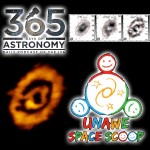Podcaster: Richard Drumm
 Title: Space Scoop: The Great Cosmic Bake-off
Title: Space Scoop: The Great Cosmic Bake-off
Organization: 365 Days Of Astronomy
Link : astrosphere.org ; http://www.spacescoop.org/en/scoops/1559/british-astronaut-blasts-off-to-international-space-station/
Description: Space scoop, news for children.
Bio: Richard Drumm is President of the Charlottesville Astronomical Society and President of 3D – Drumm Digital Design, a video production company with clients such as Kodak, Xerox and GlaxoSmithKline Pharmaceuticals. He was an observer with the UVa Parallax Program at McCormick Observatory in 1981 & 1982. He has found that his greatest passion in life is public outreach astronomy and he pursues it at every opportunity.
Today’s sponsor: This episode of “365 Days of Astronomy” is sponsored by — no one. We still need sponsors for many days in 2015, so please consider sponsoring a day or two. Just click on the “Donate” button on the lower left side of this webpage, or contact us at signup@365daysofastronomy.org.
Transcript:
This is 365 Days of Astronomy. Today we bring you a new episode in our Space Scoop series. This show is produced in collaboration with Universe Awareness, a program that strives to inspire every child with our wonderful cosmos.
Today’s story is:
The Great Cosmic Bake-off
Cooking up a Universe is fairly similar to baking at home; you take ingredients (let’s say eggs, flour and milk) put them in the right conditions (like a hot frying pan) and you end up with something new and infinitely better. Pancakes!
The Universe cooks things up in a somewhat similar way. Molecules are the ingredients that make up life, planets and many of the things we see around us, like those pancakes. But molecules themselves need to be created first.
Molecules are made up of smaller, elementary particles called atoms. For example, water is a molecule created from two hydrogen atoms and one oxygen atom. H2O. But molecules don’t sprout up just anywhere. Like most recipes the temperature needs to be just right.
In regions of space close to stars, where the temperature is too high, certain molecules can’t form. At large distances from stars, where temperatures are too low, these molecules can’t form there either. That’s because some of the necessary ingredients start to freeze out into snow and ices.
Astronomers have been using the ALMA radio telescope array to look at a young star called IM Lup in the southern constellation Lupus the Wolf. It’s 620 light years away and is surrounded by a thick ring of gas and cosmic dust that will one day form into planets. In the fall of 2015 they published a scientific paper on their results.
Examining the ring around that star – in an area 90 AU from the star where the temperature is just right – they found gas containing delicate molecules of DCO+. That’s a molecule made from deuterium, carbon and oxygen.
Deuterium is also called heavy hydrogen because it’s atom has a neutron in its nucleus adding extra weight. Ordinarily there’s just one proton in there. The plus symbol there means the molecule has had an electron stripped away, giving it a overall positive charge.
But no surprises there. We’ve seen this molecule before. It was first detected in 2003 around the orange dwarf star TW Hydrae in the constellation of Hydra the Sea Serpent by one of the co-authors of this paper.
The big surprise was that they then found more gas made of those molecules in a second ring 300AU away from the star’s heat. As it turns out, UV light from the star is doing the, uh, “cooking” out here! You can see the two rings in the awesome new picture in the lower left corner of today’s album artwork.
In the upper right corner you can see 3 so-called integrated emission maps, one for CO, carbon monoxide, and ones for HCO+ and DCO+. You can easily see that each molecule forms at a different distance from the star.
At first glance, this result doesn’t seem to be too impressive. But to astronomers, it’s very important. It tells us that molecules can be made in places we wouldn’t expect. The Universe has lots of surprises in store for us. Lots!
Eventually, this finding may shed light (Ha! See what I did there?) may shed light on the distribution of molecules in our own Solar System, which formed billions of years ago from an accretion disc quite similar to the one surrounding this young star.
Hey, Here’s A Cool Fact:
Molecules are like interstellar messengers that tell us how, where and in what kinds of physical conditions different types of molecules form. The molecules found on Earth tell us most of our water is even older than the Sun! But that’s a story for another day…
Thank you for listening to 365 Days of Astronomy!
End of podcast:
365 Days of Astronomy
=====================
The 365 Days of Astronomy Podcast is produced by Astrosphere New Media. Audio post-production by Richard Drumm. Bandwidth donated by libsyn.com and wizzard media. You may reproduce and distribute this audio for non-commercial purposes. Please consider supporting the podcast with a few dollars (or Euros!). Visit us on the web at 365DaysOfAstronomy.org or email us at info@365DaysOfAstronomy.org. This year we will celebrate more discoveries and stories from the universe. Join us and share your story. Until tomorrow! Goodbye!

